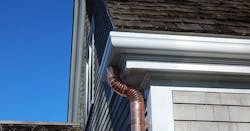Money in the Gutter
While scrolling through his company’s Yelp reviews a few years back, a San Francisco roofer came across a one-star entry bristling with irritation and complaint. The homeowner claimed to have water entering the house from a roof that the company had installed less than five years prior. The roofing company owner tracked down the customer and offered to come out to the house to inspect. Sure enough, water entered every time it rained. The reason? Gutters and downspouts, never cleaned, were plugged full of leaves and debris. “I told him it was a maintenance issue,” the company owner says. The review was upgraded to five stars.
Don’t Walk Away
Maintenance is a must when it comes to gutters, which is something some homeowners only discover when water is dripping from their drywall ceiling. Beyond that, homes with failing roofs often have gutter issues as well. No surprise there. Metal gutters have about the same lifespan as a shingle roof. They just fail in different ways.
Even gutters that are regularly cleaned of plant matter and debris will rust, leak, sag, or pull away to the point where they can’t do what they’re designed to do, which is shed water and direct it away from the house. Gutter issues are easier to spot than problems with a roof, contractors point out. “You don’t really know the exact roofing issues until you get up at eye level,” says Ron Hall, sales manager at Russell Roofing, in Oreland, Pa. With gutters, you can see installation errors from the ground, he says, and they often have to do with skimping on hangers, which causes sag. And when they’re a problem, they’re a problem that even a brand new roof isn’t going to make go away. Which is why, at both Russell Roofing and All County Exteriors, in Lakewood, N.J., roofing salespeople routinely include an estimate for gutter replacement in re-roofing proposals. “We’ve elected to make gutters part of our mix,” says All County’s sales manager Russ Dorrycott. The company has its own gutter crews and its own machine for forming seamless gutters on site (see a gutter machine in action here).
When it comes to gutters, roofing companies have choices. Since gutter replacement may add as much as 30 percent to the cost of the total job, one option is to simply ignore gutter problems. Another is to address gutter issues, recommend replacement, and include the cost as a separate number. Hall notes that many customers, seeing what they’d pay to replace gutters and downspouts and being aware that that cost will be more later and if done separately, quickly change their minds. Kelly Roofing, in Naples, Fla., similarly includes gutter replacement in its scope of work and generates enough gutter replacement to sustain its own installation crews. “I don’t want to sell something to someone who doesn’t need it,” president Ken Kelly says, “but if I go to the house and see that the foundation is eroding and they need gutters on one side, why should I walk away from solving their problem?”
Photo: Flickr user Eric Schmuttenmaer (CC by-SA 2.0)
In-House Crews
New gutters can add anywhere from $2,000 to $5,000 to the cost of a roofing job, depending on the size of the house and complexity of the roof, and it takes, says Tania Goodman, president of Majestic Exteriors, in New Jersey, three or four hours to form and install gutters, a process she insists is as necessary for her company’s re-siding jobs as it is for a re-roof. Majestic also uses its own gutter crews, operating a gutter-forming machine the company bought five years ago for $11,000.
Having your own gutter crews takes a certain volume of work for roofing and siding companies. It also takes some management assertiveness. For instance, Kelly Roofing partnered with its gutter supplier to send some of its roofing installers to South Carolina for gutter installation training. Bringing gutter work in-house was a commitment, and Kelly says there is a basic principle underlying any such decision. “I will not take on a product line if I can’t pay off the investment in two years,” Ken Kelly says. Kelly Roofing paid off its investment in the gutter machine in less than a year. But he has another reason for making gutters part of a job whenever called for. “It costs a certain amount to acquire a client,” Kelly notes. And when you acquire a roofing client who also needs new gutters, you’re not paying that cost.
Subs Who Specialize
Many roofing companies prefer to sub out gutters to contractors specializing in just that, which is fine with specialty gutter companies. “Here’s what we tell roofing companies,” says Tim Brown, president of Rain Gutter Specialties & Exteriors, in Salt Lake City, which specializes in gutters. “Here is what we’d charge the customer. You charge the same thing and we will give you a discounted rate. So they don’t have to do anything and they still make 20 or 30 percent.”
Rain Gutter Specialties doesn't do roofing, so that if its estimator arrives at the house on a gutter appointment and determines the roof is shot, standard practice is to recommend replacing the roof first. “We probably hand 50-plus leads a year to roofing contractors,” Brown says. That’s because if the roof is compromised, new gutters won’t solve the problem, though homeowners don’t actually know that. “Seventy to 80 percent of our callbacks have nothing to do with the work we did,” Brown says. “They’re problems we didn’t know about. The homeowner will call and say: ‘There’s water dripping behind the gutter. It never did this before.’” At which point, the company dispatches a service tech to perform a water test to trace the leak, which almost always is found to originate in the roof, often from faulty flashing.
Referral Relationship
Gutter specialty companies typically split their energies between subcontracted installations for roofers and builders and gutter jobs they sell to individual homeowners. But experience teaches them to choose clients wisely. “We still work for roofing companies,” says Ryan Parsons, of The Brothers That Just Do Gutters, in Poughkeepsie, N.Y., “but only the ones whose values align with ours—the ones that are organized, show up on time, return calls, and care about the client experience.”
Still, The Brothers far prefer working for homeowners rather than roofers. Payment is one reason. Parsons estimates that “one in 300” homeowners might stiff The Brothers at the end of a job; something that would happen far more frequently with roofers. So although The Brothers do subcontracting as well as get referrals, it’s the referrals that are most prized, since the company can sell and install the job on its own terms. Since The Brothers—which also franchises its operation—mounts its own formidable marketing effort, it's in anywhere from 75 to 100 homes per week, and is in a position to recommend roofing contractors to homeowners who obviously need more than just new gutters.
Dedicated Subs
A roof keeps rain from entering the house. Gutters carry the rain off. But not every roofing company wants, needs, or can afford to be in the gutter business. “We look at the holding cost of the machinery,” says Mark Watson, owner of Exterior Medics, a $10 million roofing company in Northern Virginia. “There’s the cost of the machine, the coils you have to stock, the maintenance, and, frankly, if we manage and maintain a good, healthy relationship with a subcontractor, then there’s no need to do it internally."
Exterior Medics salespeople look at both roofs and gutters, since often enough even if gutters aren’t failing they may have other problems. For instance, being undersized (4-inch gutters on a big roof), or not properly pitched (say a vertical 1/2 inch for every 10 feet of horizontal gutter). Gutters—today usually 5-inch or 6-inch—may all look alike, but estimating the right size and the corresponding number of downspouts comes from calculating square footage and roof pitch, that is, how much water running how fast. “You want to see how much of a run you have, what’s the distribution, and what are the allocation of downspouts,” Watson says.
Often homeowners looking for a new roof have never even thought about gutters, which is why All County Exteriors reps have a five-minute, 10-slide presentation for the iPad that reviews common problems and solutions for gutters. “We’re there to discover the issues,” Dorrycott says. “That includes gutter issues. And when our estimators talk about roofing options, we will also talk about gutter options.”


